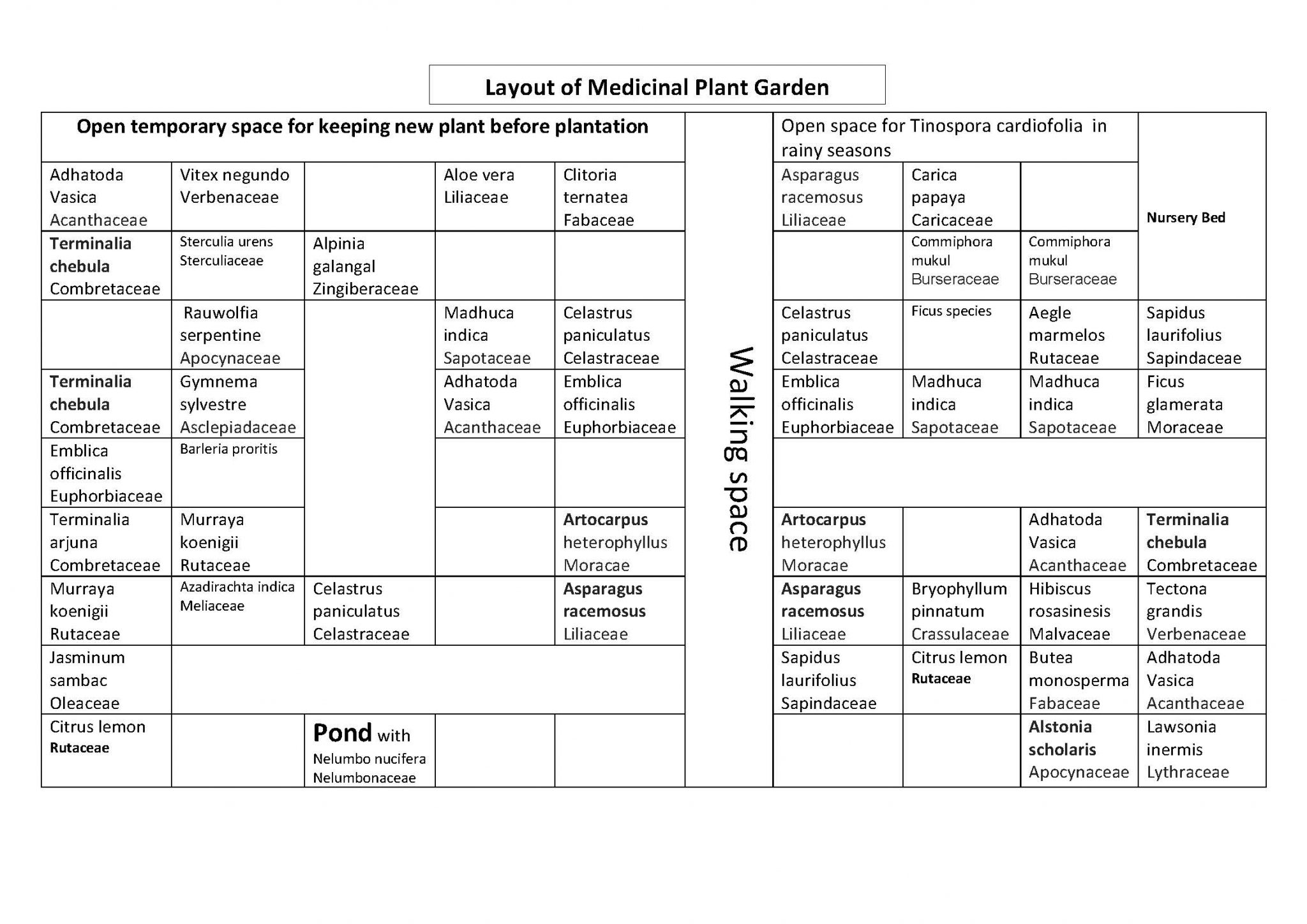Medicinal Plant Garden
Area: 3500 Sq ft
Demarcation: done with fencing and ornamental plants
Temporary/permanent arrangement: temporary arrangement is available as area to keep the barrowed new plants. Most of the plants were planted in the medicinal garden at their permanent place. The seasonal plants planted in nursery beds
Planting of plants under the shade in demarcated areas: 31 different species planted in medicinal plant of local flora, and medicinal importance based on the curriculum
Adequacy of the plants: Yes


Institute has established the medicinal plant garden from the date of inception of institute. We have established an arboretum of medicinal plants in an area of about 3500 Sq. feet. The objective of establishing this garden is to maintain a conservatory of the most common and important species of medicinal and aromatic plants which are being used in day-to-day primary health care. All the plant species were authentically identified by expert taxonomists, labeled and in many cases their therapeutic values in curing different diseases are also highlighted.
The medicinal garden lay out has been designed in such way that the bigger medicinal plants are planted at the periphery of garden. The demarcation of the garden has been carried out by lowsonia plant and fencing.
Medicinal garden also has facility of green house shed which is used as rest of new plant arrival and growing of the medicinal plants of different climate conditions. It also has a artificial water pond for aquatic plants. All the medicinal plants are drip irrigated.
The medicinal garden has more than 70 plants belonging to 35 different species. In various categories as seasonal, ornamental, traditional medicinal, nutraceutical and cosmetic plants
The seasonal plants are planted in nursery beds based on the plants natural germination time. Plants mostly includes of academic importance with therapeutic potential. The Capsicum annuum (solanaceae), Aloe vera (liliaceae), Datura metal (solanaceae), Phyllanthus niruri (Phyllanthaceae), Curcuma longa (Zingiberaceae), Zingiber officinale (Zingiberaceae) are planted on regular basis annually. These plants are mentioned for practical in our regular curriculum.
The ornamental plants best suited for this climate are planted are of different verities of Rose species (Rosaceae), Jasminum sambac (Oleaceae); Hibiscus rosa-sinensis (Malvaceae), Jasminum officinale (Oleaceae) and Nelumbo nucifera (Nelumbonaceae). They are rich in fragrance and has great importance in cosmetics.
The cosmetic plants such as Bixa orellana (Bixaceae), Lawsonia inermis (Lythraceae), Curcuma longa (Zingiberaceae), Hibiscus rosasinesis (malvaceae); Butea monosperma (Fabaceae); are being planted and used for regular practical’s
The nutraceutical plants such as Citrus lemon (Rutaceae), Murraya koenigii (Rutaceae), Ficus glamerata (Moraceae), Ficus carica (Moraceae), Emblica officinalis (Euphorbiaceae) and Curcuma longa (Zingiberaceae) are in fruiting and maturity stages. These are being regularly discussed during the visit of students
The traditional medicinal plants includes Adhatoda Vasica (Acanthaceae); Aegle marmelos (Rutaceae), Alpinia galangal (Zingiberaceae), Alstonia scholaris (Apocynaceae); Asparagus racemosus (Liliaceae); Boswellia serrata (Burseraceae); Bryophyllum pinnatum (Crassulaceae); Celastrus paniculatus (Celastraceae); Cassia fistula (Fabaceae); Clitoria ternatea (Fabaceae); Emblica officinalis (Euphorbiaceae); Gymnema sylvestre (Asclepiadaceae); Madhuca indica (Sapotaceae); Rauwolfia serpentine (Apocynaceae) Sterculia urense (Sterculiaceae) Terminalia arjuna (Combretaceae); Terminalia chebula (Combretaceae); Tinospora cardifolia (Menispermaceae); Vitex negundo (Verbenaceae) are planted in medicinal garden; amongst these Commiphora weighti (Burseraceae); Boswellia serrata (Burseraceae); is mentioned as critically endangered in the IUCN Red List of Threatened Species
List of plant varieties available in medicinal plant garden
|
Adhatoda Vasica Acanthaceae |
Emblica officinalis Euphorbiaceae |
|
Aegle marmelos Rutaceae |
Ficus glamerata Moraceae |
|
Aloe vera Liliaceae |
Gymnema sylvestre Asclepiadaceae |
|
Alpinia galangal Zingiberaceae |
Hibiscus rosasinesis Malvaceae |
|
Alstonia scholaris Apocynaceae |
Jasminum sambac Oleaceae |
|
Artocarpus heterophyllus Moracae |
Lawsonia inermis Lythraceae |
|
Asparagus racemosus Liliaceae |
Madhuca indica Sapotaceae |
|
Bryophyllum pinnatum Crassulaceae |
Murraya koenigii Rutaceae |
|
Butea monosperma Fabaceae |
Rauwolfia serpentine Apocynaceae |
|
Caffea arabica Rubiaceae |
Sapidus laurifolius Sapindaceae |
|
Carica papaya Caricaceae |
Sterculia urense Sterculiaceae |
|
Cassia fistula Fabaceae |
Tectona grandis Verbenaceae |
|
Celastrus paniculatus Celastraceae |
Terminalia arjuna Combretaceae |
|
Citrus lemon Rutaceae |
Terminalia chebula Combretaceae |
|
Clitoria ternatea Fabaceae |
Tinospora cardiofolia |
|
Commiphora weighti Burseraceae |
|
LAYOUT OF MEDICINAL PLANT GARDEN

